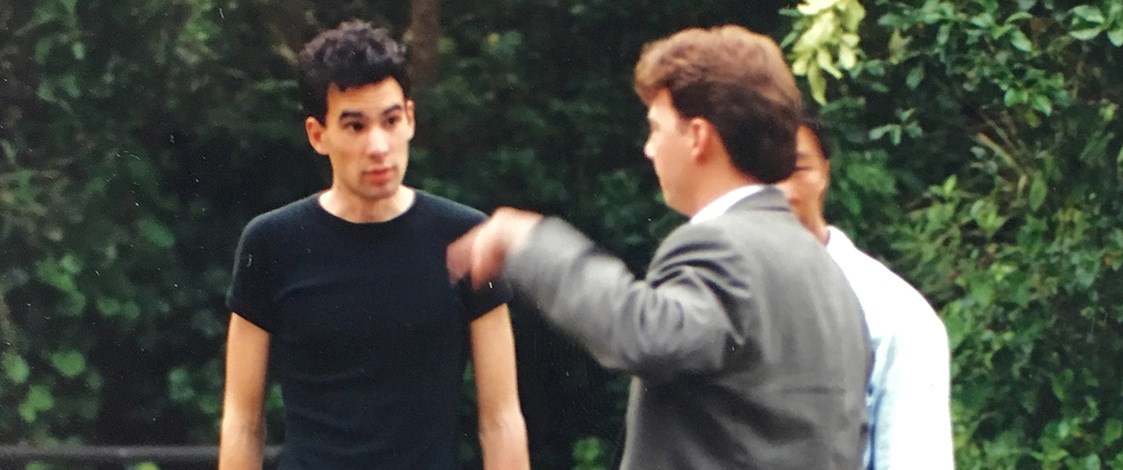Stories
Adam Custins
1972-

It was clear from the beginning that fashion would be the creative focus for Adam Custins. Despite toying with the idea of becoming a designer (his mother and grandmother taught him to make clothes from a young age) his love of photography won out, and he set up his own studio at the age of 19. He considers those early years as some of "the most formative and raw periods in New Zealand fashion".
Born in 1972 to Chinese-English parents, Adam grew up in suburban Auckland. His family were members of the School of Philosophy, which he attended until he was 16 - a year after he was given his first camera. High school years were spent around High Street, warehouse parties and low-fi fashion shows and this is where his photographic imagination was first captured. He carried his camera everywhere. Adam considers those early years as some of "the most formative and raw periods in New Zealand fashion". Town was buzzing with creativity, the perfect place for a young photographer starting out in the industry. "I remember Karen Walker striding down High Street in her sequinned hot pants and hooded sweat looking like she’d just landed from planet fashion." Everything was hands on, self taught or mentored by supportive industry professionals.
In 1993, Adam attended a short course at Brooks Institute of Photography in California, which gave him much of the technical and professional foundation he needed to succeed in his work. His first official shoot was for Karen Walker, "a one page ad for a self published magazine called PILOT I was making with art director, Justin Jones", Adam says. He was so excited to work for her that he photocopied the cheque.

Adam Custin's first official photoshoot was for Karen Walker, "a one page ad for a self published magazine called PILOT.
He worked with Justin for a few years after that first shoot, picking up Working Style as a client and gaining more and more experience in the fashion world. Viewing fashion photography as "a bare canvas for any kind of idea or expression" meant that Adam was very open to learning and experimentation. His style underwent a complete change in 2010, when he decided to "radically simplify". Instead of continuing to use artificial lighting, large crews and intensive styling, he stripped everything right back to basics, and there he found the aesthetic that defines his work today. "I felt that if I was going to really progress as a photographer, I needed to virtually relearn how to make powerful images with the least amount of stuff," he says.
Specialising in Polaroid film gives Adam’s images a dreamy, otherworldly feel. Colours saturate oddly on the instant film, which is often long expired before Adam brings it back to life, and the natural light gives his subjects softened edges and unexpected contrasts. He admits to increasingly referencing past experiences in recent work: his aesthetic "often imagines two worlds: one that is very natural and idealistic, almost puritanical/Amish. The other, hedonistic, and free."
The move into film brought with it other shifts, both conceptual and geographical. Adam was based for a time in New York (a city notoriously difficult to crack) and there he had a missed opportunity that was one of the "most satisfying" moments in his career. "After two years slaving away trying to make an impression, I finally got to meet with the photo agent of my dreams: Art + Commerce, in 2012", he says. "They offered to take me on but I wasn’t able to get my Visa in time." It may not have been fate this time, but it wasn’t the end of his New York dreams: in 2016, Adam had his first New York exhibition, showing personal work alongside another instant-photographer, Colby Sadeghi.
In 2013, fashion journal Vestoj and the National Gallery of Victoria invited him to collaborate on a shoot for the NGV costume collection. The work was an exploration of the inner structure of garments; Adam was asked to shoot only the inside of each piece. "They specifically asked me to shoot this because of my Polaroid work," Adam explains, "I used expired film that had only been made by accident in the Polaroid factory years ago. It helped to mirror the fragility of the costume pieces which in many cases were couture, so also one off."
The work with NGV is a perfect summation of Adam’s own practice: fashion meets art, but the story and the people behind it are always the driving force. While fashion is still very much a part of Adam’s work, fine art and documentary work have become of equal importance. "Most of all it’s [about] being with like minds. [Being with] others who would eat soup if it meant they could just create."
2017 brings new challenges. Film is a struggling media, and recently the main film stock that Adam uses has been discontinued, with no immediate replacement. "I am pushing myself to explore other mediums while also stockpiling film," he says. "It is interesting but also quite sombre, as I only have 100 packs left for the rest of time." Facing such an insurmountable limitation would be enough to dishearten any artist, but Adam is rising to the challenge. "What I love about photography is that I am constantly evolving... I can always be better."
Text by Arielle Walker. Banner image © Adam Custins.
Last published June 2017.